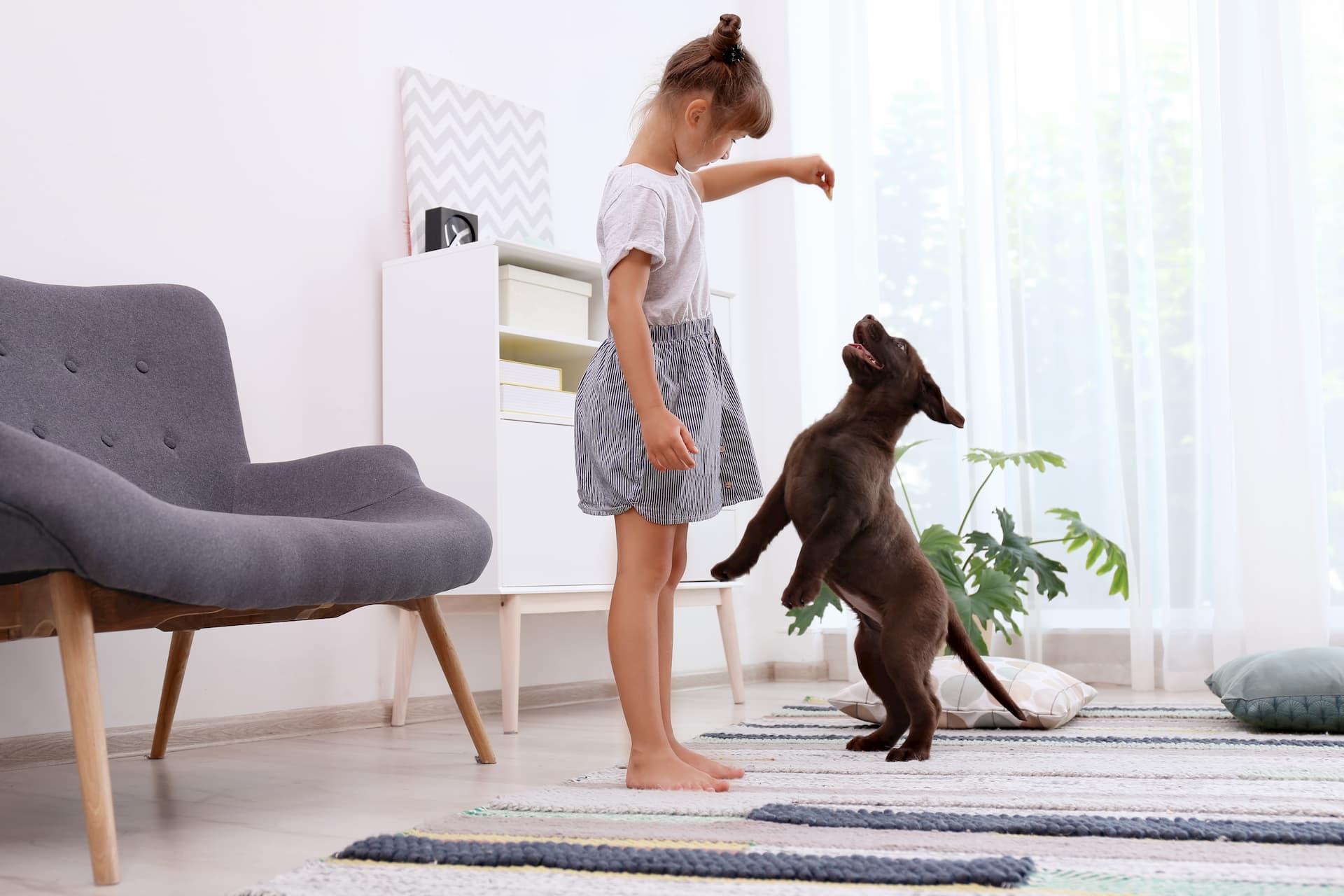Learning to come when called is the most important skill that all dogs should learn, and this is the key to your dog’s safety and your peace of mind. That is why the “Come” command should be executed instantly and no matter what is going on around.
At what age should you start training your puppy to come when called?
You can start training your puppy as soon as they come home, that is, around 8 weeks old. The only important thing here is to keep the training sessions short so that your pup is not bored or tired.
How do you teach a puppy to come when called?
- Start training your pup or older dog the moment you bring them to your house. Don’t wait until your puppy grows up. The sooner you start training, the easier the learning process will be.
- Use different types of rewards (a treat, a toy or verbal praise) when the puppy comes to you. Turn each time you call your pup by their name, giving the “Come” verbal cue and when the puppy comes to you, into a joyful event. It is important to make teaching recall a fun and interesting game for your dog.
- Train your dog at their height level. Do not hang over your dog’s head, better to squat or kneel to your dog instead.
- Don’t be scary or boring to your dog. The more you motivate your dog, the more willingly they come to you. Dogs love to follow people, and only improper training can discourage them from doing so.
- When the puppy runs up to you, make sure to touch them by the collar or harness. Sometimes dogs learn to run up to the owner, but not close enough to reach them. This happens when the owner calls the pet only when he wants to put them on a leash and take them home. Dogs are smart and they learn quickly that in this case it is better not to come too close to the owner. Teach your dog to run up close to you, take them by the collar or harness, give them a treat and let them go again. This way your dog will never know why exactly you called them: either to take them on a leash or to give them something tasty.
- Call your puppy cheerfully and never scold them if they run up to you. If you call your dog a number of times and they do not come back to you, do not scold them when they eventually return. It is understandably annoying when your dog ignores you, but if you get angry when they finally return, they are unlikely to respond the next time you call them.
- Ask for assistance. Take turns calling your dog so that they run from one person to another. Each time your four-legged friend comes to you or your assistant when called, praise them.
- Don’t make training sessions too long. Dogs get tired and lose interest quickly so the classes should be short and you should end them while your pet is still ready to learn.
- Use a signal (a verbal cue or a gesture) that your puppy hears or sees clearly. Make sure that your pet can see or hear you when you call them.
- Increase the level of complexity gradually. Start increasing the distance from which you call the dog and praise them for their compliance. If your pet doesn’t respond, go back to the previous stage and repeat.
- When training becomes more advanced, the reward should be more valuable. The more stimuli there are, the higher the dog’s motivation should be. Use what your dog loves more than anything as a reward for their obedience, especially in the presence of stimuli.
- Give the “Come” command only one time. If you repeat a command because your dog doesn’t listen, you teach your pet to ignore you. Do not give the command in the early stages of the training process if you are not sure your dog will follow it. But if you give the command, do everything you can to capture your pet’s attention and to encourage them to run to you.
Is it possible to teach your puppy to come when called in 2-3 days?
Well, probably, yes if you practice the “Come” command in a stimuli-free environment where your pet feels boredom and knows that if they react to the command they’ll get some tasty treats.

But unfortunately, such commands, which seem to be simple and basic to us, sometimes interfere with our pet’s natural needs, that is, for instance, playing with other dogs. Your pet is so busy playing, they hear the “Come” command and they think “Oh, wait! Why should I leave this game? Why should I go to my human when I am so happy here?” Playing or exploring the world around is typical behavior for any dog.
It will take some time (much longer than 3 days) and effort to train your dog to come when called in a stimuli-saturated environment full of distractions.
It’s best to train your pet using different games (first simple, then advanced), using positive reinforcement. Your initial aim is to teach your pet what the “Come” command is and when it is used.
In the future, you’ll begin to work with more complex situations and train the dog to choose between you and a stimulus. The next step is to teach your dog to choose the owner in the presence of a stimulus, and then we teach the dog to stop when they run to the stimulus, and return to the owner.
When teaching your puppy to come when called, let them off the leash only when you see that they listen to you. If they don’t come up one time, then you shouldn’t let them off the leash. Instead, spend more time on training the recall — first, on the leash, then on a thin rope, then with the leash on the ground. If the puppy unconditionally follows the command, you can let them off the leash and continue practicing the recall.
15 tips on how to train your puppy to come when called
We’ve prepared 15 tips that will help you to train your puppy or even an older dog to come when called.
- At the beginning, give the “Come” command only when the puppy is already running toward you and you can see that they won’t get distracted by anything.
- If the puppy doesn’t pay attention to you, call the puppy’s name first, get their attention, and only after making sure that the dog has started moving towards you, give a verbal cue.
- Start your training in a low-distraction environment. You can start training at your house or in some other quiet places where no people or dogs can distract you.
- Do not let the dog off the leash in places and situations where you are not sure that they will return.
- Do not repeat the “Come” verbal cue many times if the puppy ignores you. By overusing the “Come” command, you will devalue the command itself and the dog will stop responding to it.
- If the dog has stopped responding to the “Come” command, introduce a new verbal cue, for example, “Here” and start training again.
- Make coming to you enjoyable and always praise your puppy with a treat or a toy. Your dog should think that coming to you is the best thing imaginable and that it brings a lot of joy.
- Surprise your puppy with various treats. Sometimes reward the pup with dry kibble and sometimes – with high value treats. Figure out what your puppy likes best; it can be, for example, chicken, cheese, or liver.
- Always raise your pup’s interest in you. You can reward the puppy’s coming to you with a treat, or you can suddenly take a toy and throw it to them, let the dog grab it and play their favorite game.

- In the first stages, it is important to pay attention to the puppy and avoid situations when the dog gets distracted by something and runs away from you. If you can’t keep an eye on your puppy, keep them on the leash.
-
Come up with some games to keep your
puppy’s attention.
- You can call the puppy by their name and run away from them.
- You can follow your usual route, let the puppy go ahead, and then say “Fido, come!” and turn the other way.
- When the puppy starts tracking you on a walk – start changing direction without warning, but always reward the dog when it catches up with you.
This will teach your dog to watch you carefully because you are unpredictable. Your puppy will be afraid to lose you if they don’t keep track of where you are going.
- The fastest way to teach your puppy NOT to come when called is to let them play with every single dog they see. This will confirm the idea that you bring less fun than other dogs and that you are predictable and therefore, boring. This may also get your puppy into trouble because even if your pup is friendly, it doesn’t mean that the other dog is friendly as well.
-
When you see other dogs and you don’t
mind your pup playing with them, teach
them the following ritual: “You come
to me, you sit, and I let you do and
play.” In the beginning, you can ask
dog owners you know for assistance.
Let them just wait a couple of minutes
before bringing their dog to you. At
this moment you will make your puppy
sit and look at you. In fact, this is
almost like how we act with
children.
- “ Mom, may I go and play with Alex?”
- “Yes, of course you may as you asked for permission.”
Soon this model will work with any dog you’ve met.
- Teach your puppy that the sooner they come to you, the sooner they can go back to what they were doing before you called. That means that you not only call your dog when you want to take them away from something interesting, but most often that you act according to the “recall-reward-back to walk” algorithm. The puppy will soon realize that the “Come” command doesn’t mean the end of the fun and they will come to you with pleasure.
- Always remember that practice makes perfect. If you repeat all the exercises described above, you will teach the puppy to always come when called on each walk for at least two months. Stay positive and keep in mind that a reliable “Come” command can be a literal lifesaver.
